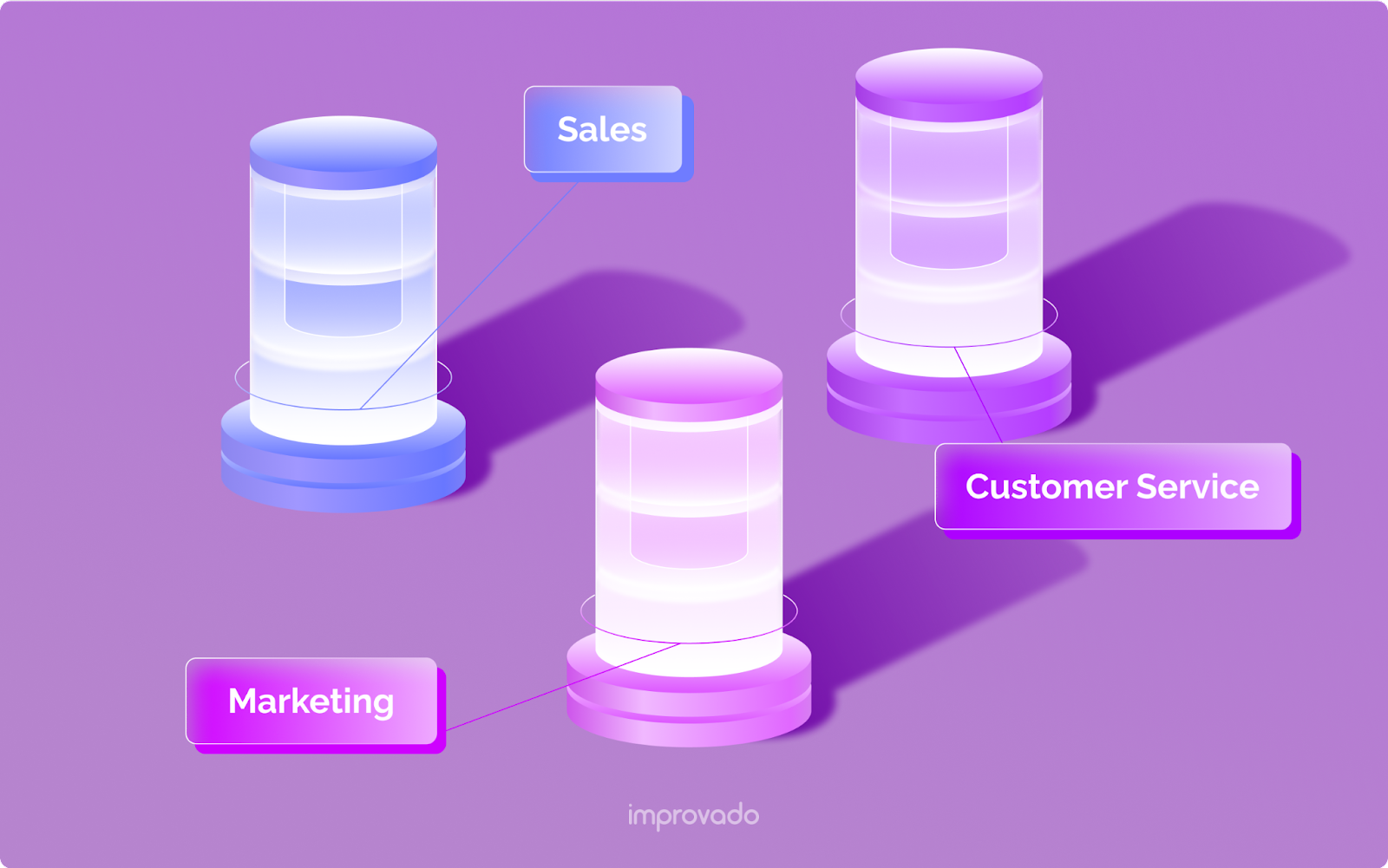Data silos aren’t just a technical inconvenience. Silos block revenue clarity, slow decision-making, and produce competing versions of truth across teams. The result is delayed reporting, inconsistent attribution, and fragmented visibility into how growth actually happens.
This article digs into the real business impact of siloed data and what it takes to break those walls down. We’ll explore how silo elimination enables unified revenue reporting, reliable attribution, cross-channel activation, and faster experimentation cycles.
Key Takeaways:
- Definition: Data silos are isolated sets of data accessible by one department but not others, leading to fragmented business intelligence and operational inefficiency.
- Why They Form: They are unintentionally created by organizational structures, incompatible technologies, rapid growth without proper data governance, and a culture that doesn't prioritize data sharing.
- The Business Impact: Silos are highly problematic, causing flawed decision-making, poor customer experiences, wasted resources, and significant security risks.
- The Solution: Breaking down data silos requires a combination of strategic planning, cultural change, and the right technology, such as automated data integration platforms that create a single source of truth (SSOT).
What Are Data Silos? A Foundational Understanding

A data silo is a systemic problem. It represents a barrier to data flow, both technologically and culturally. Data becomes siloed when it is stored in a system that doesn't integrate with other systems, controlled by a team that doesn't share it, or formatted in a way that's incompatible with other datasets.
The result is a fractured view of your business operations, where each department sees only a small piece of the puzzle.
The Anatomy of a Silo: Where Data Gets Trapped
Data silos can exist in many forms across an organization. They can be as simple as an analyst's spreadsheet stored on a local drive or as complex as a proprietary, cloud-based SaaS platform that doesn't offer data export APIs.
Common places where data gets trapped include:
- Department-specific applications (e.g., a CRM for sales, a marketing automation tool for marketing)
- Legacy systems with limited connectivity
- Spreadsheets and local databases used for ad-hoc analysis
- Third-party platforms that restrict data access (vendor lock-in)
Siloed Data vs. Centralized Data: A Core Distinction
The opposite of a siloed environment is one with a centralized, unified data architecture.
In a centralized model, data from various sources is collected, standardized, and stored in a central repository, typically a data warehouse. This allows authorized users from any department to access a consistent, comprehensive, and up-to-date view of the entire business.
This single source of truth is the foundation for accurate reporting, deep analysis, and truly data-driven decision-making.
The Root Causes: Why Do Data Silos Form in the First Place?
No one sets out to intentionally create data silos. They are the natural by-product of organizational growth, technological evolution, and human behavior.
Understanding their origins is the first step toward dismantling them.
Organizational Structure and Departmental Friction
The very way most companies are structured can foster silos.
Departments like marketing, sales, finance, and customer support are created to specialize and focus on specific functions. While this improves efficiency within a department, it can create invisible walls.
Each team adopts its own tools, processes, and metrics, inadvertently hoarding data that could be valuable to others. A competitive internal culture can exacerbate this, turning data sharing into a political issue.
Technological Sprawl and Incompatible Systems
As companies grow, they adopt a wide array of software solutions to meet specific needs: a CRM for sales, an analytics tool for marketing, an ERP for finance. This tech stack often becomes a patchwork of systems from different vendors that were never designed to communicate.
Without a deliberate integration strategy, these incompatible systems become digital silos, each trapping its own valuable dataset. The complexity of combining data from these disparate sources often requires advanced data integration tools to overcome.
Rapid Business Growth and Immature Data Governance
Growth is a good thing, but when it's rapid and unplanned, data management practices often get left behind.
New departments, employees, and software are added quickly, and in the rush to scale, establishing a cohesive data strategy is rarely a priority.
Without clear data governance employees are left to their own devices, leading to inconsistent data practices and the inevitable formation of silos.
Cultural Barriers and Lack of a Data-Driven Mindset
Ultimately, technology is only part of the problem. A company's culture plays a massive role.
If data is viewed as a departmental asset to be guarded rather than a shared organizational resource, silos will persist regardless of the technology in place. A lack of data literacy, where employees don't understand the value of shared data or how to use it, further reinforces these barriers.
True data unification requires a cultural shift towards transparency, collaboration, and a collective commitment to data-driven decision-making.
Common Examples of Data Silos in Modern Business
Data silos are not an abstract concept; they manifest in tangible ways that impact daily business operations. Here are some of the most common examples found in nearly every organization.
Marketing Data Trapped in Ad Platforms and MarTech Tools
The modern marketing department uses dozens of tools: Google Ads, Facebook Ads, LinkedIn Ads, SEO platforms, email marketing software, and more.
Each platform generates a wealth of performance data, but it all lives in separate, disconnected systems. This makes it incredibly difficult to get a holistic view of marketing performance or accurately measure ROI across all channels.
Sales Data Confined to CRM Systems
The sales team lives in the CRM (for example, Salesforce or HubSpot). It contains a treasure trove of information on leads, opportunities, deal stages, and customer interactions.
However, if this data isn't shared with the marketing team, marketers can't see which campaigns are generating the most valuable leads, leading to inefficient ad spend and poor alignment.
Customer Support Data in Helpdesk Software
Customer support platforms (for example, Zendesk and Intercom) track every customer interaction, complaint, and feature request.
This data is invaluable for the product team to identify areas for improvement and for the sales and marketing teams to understand customer pain points.
When this data is siloed, these crucial insights are lost, and the organization misses opportunities to improve the customer experience.
Financial Data in Accounting Systems and Spreadsheets
The finance team relies on accounting software and countless spreadsheets to manage budgets, revenue, and expenses. While highly accurate, this financial data is often walled off. Without access, the marketing team can't connect their campaign spending to actual revenue, making it impossible to calculate true ROI.
The leadership team also struggles to get a real-time view of financial health tied to operational activities.
The Damaging Impact: Why Data Silos Are Problematic for Your Business
Data silos pose a significant threat to your company's performance, agility, and bottom line. The negative consequences ripple across every facet of the organization.
Compromised Business Intelligence and Flawed Decision-Making
When decision-makers lack access to a complete and unified dataset, the insights they generate are skewed and unreliable. This leads to poor strategic choices.
For example, a company might cut funding for a marketing channel that appears to have a high cost-per-lead, not realizing that the sales data would show those leads have the highest conversion rate and customer lifetime value. Silos force you to make critical decisions based on guesses and incomplete stories.
Inefficiency and Wasted Resources
Silos create massive duplication of effort and waste. Teams in different departments may unknowingly collect and analyze the same data, wasting valuable time and money.
Analysts spend countless hours manually exporting data from various systems and attempting to stitch it together in spreadsheets, a process that is both inefficient and prone to human error. This time could be better spent on generating actual insights.
A Fractured and Inconsistent Customer Experience
Customers don't see your internal departments; they see one company. When your data is siloed, this unified experience breaks down. A customer might have to repeat their issue to multiple support agents because there's no shared history. They might receive marketing emails for a product they already own or have complained about. This lack of a 360-degree customer view leads to frustration, churn, and damage to your brand reputation.
Undermined Data Integrity and Trust
When different departments report on the same metric (like new customers) and come up with different numbers, it erodes trust in the data across the entire organization.
Which number is correct?
This dueling dashboards problem forces teams into debates about data validity instead of discussions about business strategy. Without a single source of truth, data integrity is compromised, and the organization loses faith in its own intelligence.
Stifled Collaboration and Innovation
Data is the fuel for collaboration. When marketing can see sales pipeline data, they can better align their campaigns. When product teams can see customer support data, they can build better products.
Silos create departmental walls that prevent this cross-functional synergy. Innovation suffers because teams are unable to connect disparate ideas and data points to uncover new opportunities.
Increased Data Security and Compliance Risks
Scattered and unmonitored data in spreadsheets and isolated databases is a security nightmare. It's difficult to know who has access to what, to enforce consistent security protocols, and to ensure compliance with regulations like GDPR and CCPA.
A centralized data system allows for much tighter control over data access, security, and governance, reducing the risk of data breaches and compliance penalties.
Siloed vs. Integrated Data Environments: A Comparative Analysis
The difference between operating with data silos and working in a unified data environment is stark. Understanding these differences highlights the urgent need for integration.
A Step-by-Step Guide to Breaking Down Data Silos
Dismantling data silos is not a one-time project; it's a strategic initiative that requires planning, technology, and cultural change. Follow these steps to create a unified data ecosystem.
- Step 1: Secure Executive Buy-In and Establish a Data Governance Council: Breaking down silos is an organization-wide effort that needs support from the top. Present a clear business case to leadership, highlighting the costs of the current state and the ROI of a unified data strategy. Once you have buy-in, form a cross-functional data governance council with representatives from IT, marketing, sales, finance, and other key departments. This group will define the rules, standards, and priorities for the initiative.
- Step 2: Conduct a Comprehensive Data Audit to Map Your Silos: You can't fix what you don't understand. The next step is to conduct a thorough audit of your entire data landscape. Identify all the data sources across the organization, what data they contain, who owns them, who uses them, and how they are currently stored and accessed. This process will create a clear map of your existing silos and help you prioritize which ones to tackle first.
- Step 3: Define Your Data Integration Strategy: With a map of your silos, you can now define your integration strategy. Decide what data needs to be integrated, what the end goal is (e.g., a single customer view, comprehensive marketing ROI reporting), and what the new, unified data architecture will look like. This typically involves selecting a central repository, like a cloud data warehouse (e.g., BigQuery, Snowflake, Redshift), to serve as your single source of truth.
- Step 4: Invest in the Right Technology Stack: Manual integration is not a scalable solution. You need to invest in the right technology to automate the process of moving data from its source to your central repository. This is where data integration platforms come in. These tools provide pre-built connectors to hundreds of applications, automating the extraction, transformation, and loading of data and eliminating the need for complex, custom-coded solutions.
- Step 5: Implement and Automate Data Pipelines: Using your chosen integration platform, start building automated data pipelines to connect your siloed sources to your central data warehouse. A modern marketing data pipeline, for example, can automatically pull data from all your ad platforms, analytics tools, and CRM systems, clean and standardize it, and load it into your warehouse, ready for analysis. Start with the highest-priority data sources and expand from there.
- Step 6: Foster a Culture of Data Collaboration and Sharing: Technology alone is not enough. You must actively cultivate a culture that values data sharing and collaboration. This involves training employees on how to access and use the new unified data system, celebrating cross-functional wins that were enabled by shared data, and establishing clear processes for requesting and granting access to data. Make data a shared asset, not a departmental possession.
Ready to Build Your Single Source of Truth?
Improvado provides the data foundation modern marketing teams need to move beyond siloed reporting and scattered spreadsheets.
The solution centralizes all marketing and revenue data into one governed, consistent environment so every team, from performance to finance to executive leadership, operates from the same trusted numbers.
With Improvado, you can:
- Consolidate data from 500+ marketing, sales, and analytics tools, including online and offline data sources, legacy systems, and niche platforms
- Automate ETL pipelines to your warehouse with continuous freshness and governance
- Standardize naming conventions, schemas, and taxonomies across channels
- Blend cost, conversion, CRM, and revenue data for true full-funnel visibility
- Reconcile platform-reported conversions with first-party attribution models
- Maintain version-controlled data models and audit-ready lineage
- Use AI Agent to surface cross-channel insights instantly and troubleshoot data issues
The result is a single source of truth that eliminates reporting conflicts, accelerates insight generation, and gives your organization a reliable foundation for attribution, forecasting, and growth decisions.
The Technology Solution: Tools and Platforms to Eliminate Silos
Choosing the right technology is critical for successfully breaking down data silos. The modern data stack offers powerful solutions designed specifically for this challenge.
The Role of ETL/ELT in Data Unification
ETL (Extract, Transform, Load) and ELT (Extract, Load, Transform) are the core processes for moving data from a source system to a destination like a data warehouse.
Reliable and efficient ETL processes are the backbone of any data integration strategy. They automate the otherwise manual and error-prone work of collecting, cleaning, and consolidating data from dozens of siloed sources.
Centralizing Data with a Cloud Data Warehouse
A cloud data warehouse is the modern solution for creating a single source of truth. These platforms are designed to store and analyze massive volumes of structured and semi-structured data from across your entire business.
By centralizing your data in a warehouse, you break down silos and provide a single, consistent location for all your analytics and reporting needs.
Approaches to Breaking Down Silos: A Comparison
Advanced Applications: Leveraging Unified Data for Competitive Advantage
Breaking down data silos isn't just about fixing problems; it's about unlocking new opportunities. Once your data is unified, you can achieve a level of analysis and operational intelligence that was previously impossible.
Achieving Accurate Cross-Channel Marketing Attribution
With data from all your marketing platforms and your CRM in one place, you can finally solve the attribution puzzle. By connecting ad spend from each channel to lead, opportunity, and revenue data, you can perform sophisticated marketing attribution modeling.
This allows you to understand the true ROI of each channel and optimize your budget for maximum impact.
Automating Reporting for Real-Time Insights
Manual reporting is a relic of the siloed era. With a unified data source, you can set up fully automated reporting workflows. This means no more time wasted downloading CSVs and updating spreadsheets. Instead, you can focus on building insightful, real-time dashboards that empower teams with the information they need, when they need it.
Effective reporting automation transforms the analytics function from a reactive report-builder to a proactive strategic partner.
Creating Holistic KPI Dashboards for Leadership
Leadership needs a high-level, cross-functional view of the business. Unified data makes it possible to build comprehensive KPI dashboards that seamlessly combine metrics from marketing, sales, finance, and operations.
This gives executives a true pulse of the business, allowing them to spot trends, identify issues, and make strategic decisions with confidence.
The Future of Data: How AI and Automation Prevent Future Silos
The fight against data silos is ongoing. As new technologies and data sources emerge, the risk of creating new silos remains. However, advancements in AI and automation are providing powerful new ways to not only break down existing silos but also prevent new ones from forming.
AI-Driven Data Discovery and Mapping
AI algorithms can now automatically scan an organization's entire network to discover new data sources as they appear. These systems can analyze the metadata and content to understand what the data is, classify it, and map its relationships to other datasets.
This automated discovery and cataloging process ensures that no data becomes "dark" or forgotten, preventing the accidental formation of new silos.
Automated Data Governance and Quality Checks
AI can also automate many aspects of data governance. Machine learning models can be trained to automatically detect data quality issues, such as missing values, outliers, or inconsistent formatting, and either flag them for review or correct them automatically.
This ensures that all data entering the central system is clean and trustworthy, maintaining the integrity of the single source of truth.
Predictive Analytics on Unified Datasets
The ultimate goal of unifying data is to use it for advanced analytics. With a complete and clean dataset, organizations can leverage AI and machine learning for predictive modeling.
This could include predicting customer churn, forecasting sales, or identifying the next best marketing action. These advanced capabilities are only possible when the underlying data is free from the constraints and biases of silos.
Conclusion
Data silos should be gone for good.
As long as systems operate in isolation, organizations will struggle with conflicting metrics, slow analysis cycles, and fragmented customer understanding.
Improvado unifies marketing, sales, and revenue data into a single, governed environment, ensuring every team works from the same source of truth. With automated pipelines, standardized taxonomies, identity resolution, and real-time monitoring, you can eliminate manual data wrangling and unlock a connected analytics stack that supports confident, timely decisions.
Ready to break down silos and build true cross-channel visibility? Request a demo to see how Improvado transforms fragmented data into a unified growth engine.
.png)






.png)
